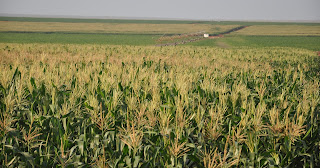Food security in Kenya: Feed the Kingpin
 |
| Galana Kulalu: More large-scale Irrigation schemes needed |
Expert reports show that Agriculture in Kenya generates 24 percent of the GDP directly, that is $18 billion at the current GDP estimated at US$75 billion. It also contributes another 27 percent indirectly to the GDP that is $20.25 billion. In effect, the sector contributes, both directly and indirectly half of the national wealth that is, $39 billion.
The sector produces 62 percent of our exports, employs 40 percent of the entire labour force and 70 percent of the rural folk. It also generates an estimated 45 percent of Government revenue. The sector also produces over 75% of industrial raw materials and more than 50% of the export earnings.
Yet, says USAID in a report, the full potential of the land suitable for agriculture is not realized. USAID, estimates that only about 20 percent of the total land mass in Kenya is arable and that 80percent of it is not fully exploited.
The bane of the agricultural sector in Kenya is the usual triumvirate- Rain-fed, lack of markets, low productivity. The result, so the argument goes; food insecurity, malnutrition and widespread poverty in the rural areas! This has led to unrealistic approaches to improving food security and poverty alleviation in the rural areas.
The usual mantra being; allocate more to agriculture, train more extension officers, create markets, do more research in agriculture. At best these proposed solutions are isolationist, treating agriculture, the backbone of the Kenyan economy as an island.
The result has been; more blame game amid declining factor productivity in agriculture and growing numbers of feed. Food prices skyrocketed, hitting the urban poor yet the rural folk are stuck in a poverty cycle. We have been suffocating the goose that lays the golden egg!
There is a positive correlation between productivity in agriculture and Gross domestic product (GNP) the measure of a country’s wealth creation. If agriculture thrives, wealth creation thrives. The reverse is also true: If agriculture shrinks, wealth creation shrinks too.
The sector so far gives more than it receives! Being the driver of the economy, it is the leading demander of goods and services produced in the country and also imports.
It therefore needs; good roads, water, electricity, Sea ports, and Airports in addition to fertilizer, improved seeds, and more extension workers. Support for the sector must be holistic.
In the past, infrastructure was designed to serve the urban economy: Water was extracted from the rural areas for drinking in urban areas and a little left for drinking by the rural households, none was set aside for agriculture, except for “kitchen gardening.” Electricity reached only cities “flying over” the rural areas while major roads had no designated markets for the rural folk.
 |
| More Multipurpose dams needed |
Without supporting infrastructure, the rural folk cut their losses by growing only what they need for their own consumption and a little to sell to buy sugar and salt.
The result; high food prices in the urban areas, hitting the poor in urban areas hardest.
Time to change gears is now. Agriculture must be the major driver in the design of infrastructure projects. Infrastructure design must of necessity include the needs of the rural folk. This, I think, is what is called inclusive development. Major trunk roads designs must include designated market slots tarmacked with parking bays -whether the market at the time exists or not. This is because roads create markets for goods. That is why hawkers are found at road bumps selling their wares, largely agricultural produce.
In addition, there is need to build all-weather roads linking the hinterlands to the major highways so that transporting farm produce to the market- whether local or to the cities- is cheap, fast, and reliable.
 |
| Roads: Not just expressways: Must have designated markets spaces |
Official estimates put- post-harvest losses to 40 percent to of the produce. This is mainly because agricultural produce is perishable by nature and should reach the market in a short while. No good storage will maintain agricultural produce beyond its lifespan. Therefore ease of access to markets is the answer. This will motivate farmers to grow more for the market and less for subsistence.
Further, there is need to process agricultural produce into value-added products whose shelf-life is longer. This means that the rural folk must be supplied with electricity to enable food processing in addition to other activities that support agriculture such as welding and other basic engineering activities.
And given the growing drought menace, water is no longer aplenty for the rural folk. Climate change is real and its time we changed tack. We must turn to large-scale irrigated agriculture.
There is need to scale up investment in agriculture supporting infrastructure- Multipurpose dams, roads linking the rural area to urban areas, and connection to the national grid to enable the sector to drive the economy.
These are massive investments running into billions of Dollars in sunk capital and they take years to complete. But this is the way to go. We must bite the bullet!
 |
| This is wasteful irrigation |
Kenya’s the long-term development strategy, the Vision 2030, has jolted action in infrastructure development in the last 10 years or so. Newly paved roads both in urban and rural areas are being constructed and some are complete. New power generating capacity from various sources coming on stream and a large number of rural homes and institutions are being connected to the national grid.
At the moment there are 57 small and mega- dams at various stages of implementation across the country to store water for human and livestock consumption and irrigation.
No resource is permanent, so the water must be conservatively used. Encouraging drip- technology to give plants the water they need without wasting it is the way to go. The technology is already available in the market. Drip technology for open field crops is being practiced at a small scale. The government should encourage large-scale drip irrigation in areas served by the dams. That way, it will ensure the resource is not wasted.



Comments
Post a Comment